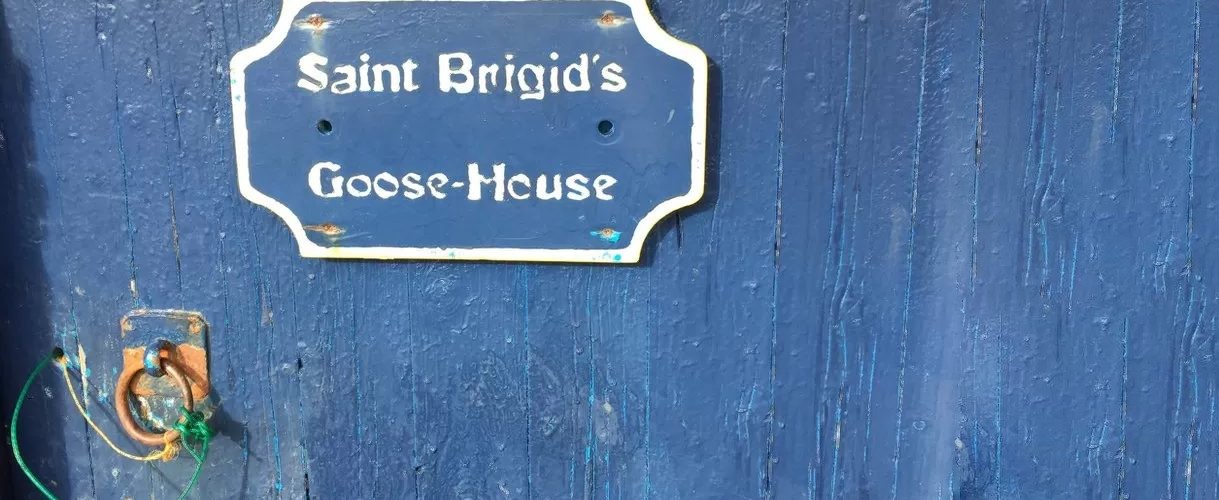Catholic Orkney
In modern times Orkney tends to be a secular community with a background of the Church of Scotland. The Roman Catholic community is certainly a minority. In pre-reformation times the Catholic Church was strong in Orkney producing a wealth of saints, from the well-known to the lesser-known – a significant feat for such a small group of islands. While the population of many Orkney Islands has declined leading to the loss of some Catholic communities, we are fortunate in Kirkwall to have a strong and consistent cohort of parishioners in addition to many visitors from Orkney’s vibrant tourist sector.
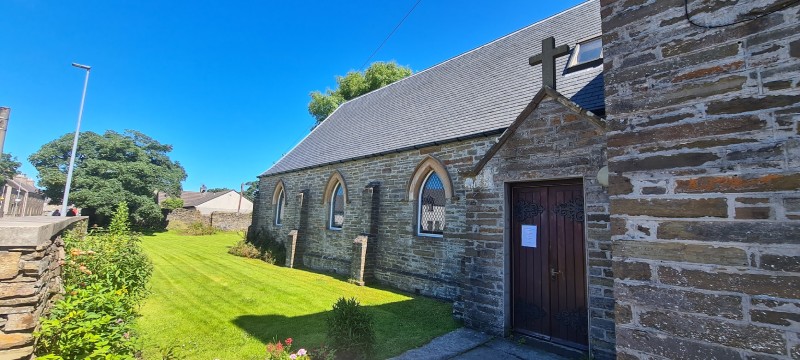
Today, we have a beautiful church in Kirkwall with the connected Chapel House. We lack a permanent parish priest but are extremely well served by the very hard-working Father Colin Davies. The building is rather old now, though, and requires significant amounts of time and investment to keep it running. Inside, we have beautiful wooden Stations of the Cross by artist Marvin Elliott.
One of the most famous or well-known parishioners of Our Lady & St. Joseph’s was the Orkney poet George Mackay Brown. Through many of his poems he explores his Christian and Catholic beliefs, often in very beautiful and reflective ways.
The Death of Mary
Used with permission of the Estate of George Mackay Brown
John, the old friend of her son,
Carried the news
From Ephesus, one spring dawn,
To the believers:
‘She is dead. Mary is dead.
The mother of Jesus.’
They had watched by her bed,
The fishermen
And carpenters and women
Whose sons had been
Her son’s comrades in Galilee.
They had watched
Through the bright streaming night
With many prayers.
She lay cold now,
The frail ivory hands
Clasping a rose from Joseph’s
Garden, her cousin.
The vine about the window
Was the same vine
That had sheltered the bee-hum
At Nazareth.
In that new dawn
Of Ephesus, they carried her
From the little stone house
To a green tomb.
John read from the scrolls.
Peter lifted his hands
In blessing, and they chanted
‘Alleluia.’
The dawn came back to the hill,
The grey-green
Olive hill, the turtle-dove’s
Homecoming.
White lilies sprang at their feet.
And the old woman
Passed into peace, under
The gold trumpets of the sun.
The Italian Chapel
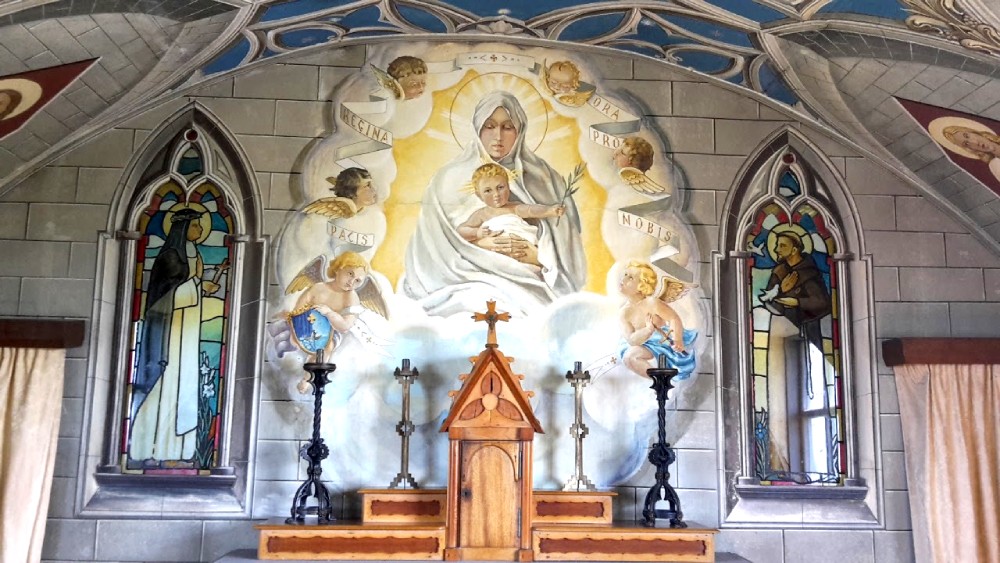
We also have the beautiful Italian Chapel on Lamb Holm. The Italian Chapel is constructed from two Nissen huts that were given to the Italian Prisoners of War to use as a chapel, who were encamped on the island of Lamb Holm from 1942-1944, while they were assisting with the construction of the Churchill Barriers. We have a page dedicated to the Italian Chapel.
Sanday

“The Sacred Heart of Jesus” Chapel, Saville, Sanday. This Chapel is at Saville, the home of two parishioners, Maurice and Jean Soord. Special permission has been given by the Bishop, for the Reservation of the Blessed Sacrament. The Chapel is open to all who wish to pray there.
Once a month, our Parish Priest visits from Kirkwall to celebrate Mass. Because he is unable to celebrate Mass frequently, there is a Service of The Liturgy of the Word and Holy Communion each Sunday at 10.00 am.

Both Maurice and Jean were born in Burma during the British Raj. In 1941, when Japan invaded, their families took different paths: Maurice’s family chose to stay, while Jean’s family joined one of the last caravans fleeing over the Himalayas into India. While the journey was harrowing for many, Jean remembers it fondly, recalling her delight at seeing snow for the first time.
After the war, Jean’s family returned to Burma but fled again to England in 1947 due to a military coup during the lead-up to independence. Maurice’s family made the same journey to England at this time. In their new life, Jean trained as an auxiliary nurse while Maurice worked as a cabling inspector for the London Underground.
Once retired and with their seven children grown, Maurice and Jean sought a rural home by the sea. They discovered “Saville,” an 18th-century former laird’s residence on Sanday, and decided to move. However, they found one significant absence: there was no Catholic church on the island.
Undeterred, the Soords gathered the other Catholic islanders and began organising Celebrations of the Word. They were appointed Eucharistic ministers by the priest on the main island, and their efforts attracted the attention of the bishop, who authorised them to convert a room in their home into a chapel. Now, they host Mass whenever a priest can visit and conduct daily Eucharistic services, bringing communion to the sick and sustaining the local faith community.
Monks of Papa Stronsay
On the island of Papa Stronsay, we are also fortunate to welcome The Sons of the Most Holy Redeemer – a Roman Catholic congregation of missionary monks. They are dedicated to a life of prayer, community, and service. Founded in the 19th century, the congregation aims to spread the message of Christ through various forms of apostolic work, including education, pastoral care, and outreach. Their mission reflects a commitment to the spiritual and social needs of the communities they serve, fostering a deep connection with both God and their neighbours.
On the island of Papa Stronsay, the congregation has established a vibrant monastic presence that enriches the local Catholic community. The monks live a contemplative lifestyle marked by regular prayer, the celebration of the sacraments, and a strong emphasis on spiritual formation. Their daily routine includes communal prayers, Mass, and personal reflection, creating an atmosphere of peace and devotion that attracts visitors and pilgrims seeking spiritual nourishment.
The Sons of the Most Holy Redeemer also engage in various outreach activities, including retreats, spiritual guidance, and educational programs. Through these efforts, they aim to foster a deeper understanding of the Catholic faith and encourage a robust spiritual life amongst the island’s residents and visitors. Their commitment to serving the local community exemplifies their missionary spirit and dedication to spreading the Gospel message in a meaningful way.
Find out more at papastronsay.com
Saint Magnus’ Cathedral
We, on rare occasions, have a service in St Magnus’ Cathedral.
Catholic archaeological sites of Orkney
Kirkwall
One of the reasons so many tourists like to visit Orkney is because of our wealth of historic and prehistoric sites. Many historic sites are of Roman Catholic origin. In Kirkwall, we have the Bishop’s Palace of William the Old and the first Saint Olaf’s church.
Birsay
At the Brough of Birsay, we have a small church, Saint Peter’s, and what appears to be a monastery. Apart from St Magnus Cathedral in Kirkwall, this is one of the most sophisticated medieval ecclesiastical buildings to survive in the Northern Isles. The Romanesque-style church has stone benches along the side walls of the nave, alcoves for altars on either side of the chancel entrance and a small cloister, housing the domestic buildings.
Also at Birsay, but not on the Brough, is the 1664 St. Magnus Church, built on the site of a previous church, built between 1050 and 1064 by Earl Thorfinn of Orkney. It was originally called Christ Church (or Christ’s Kirk). The earlier church was the temporary burial location of the relics of Saint Magnus after his murder and martyrdom.
Deerness
The site of the church on the Brough of Deerness offers a fascinating glimpse into the early Christian history of Orkney. Excavations conducted in the mid-1970s revealed post holes and grooves that outline the walls of a 10th-century chapel, which may have pre-Norse origins. This suggests that Christianity was practised in Orkney before the conversion of Sigurd in 995, indicating a much earlier presence of faith amongst the Pictish inhabitants. Local historian Rendall posits that the chapel could have been founded by Thorkel, situated just down the cliffs from his hall, drawing parallels to significant early Christian sites like Bamburgh and Lindisfarne.
Imagining the austere life of the monks who may have inhabited this chapel is captivating. Nestled high above the ocean, the community would have faced the harsh realities of island life. The excavations revealed the graves of two infants, buried in accordance with Christian customs, highlighting the challenges faced by early settlers. However, the absence of burial grounds for elderly monks suggests that this site also served as a secular, defended settlement, according to Wickham-Jones. This duality of purpose adds depth to the understanding of life on the Brough during this period.
The chapel experienced a revival in the 11th or 12th century following the Norse conversion to Christianity. Rebuilt in stone with a low perimeter wall, it featured a stone altar and an enclosure for burials. While the original structure was partially destroyed during World War I, remnants of the chapel remained visible, providing insight into its historical significance. The site continued to be a place of worship into the 16th century, with improvements like a flagstone floor enhancing its functionality.
Despite its abandonment, the chapel maintained its status as a pilgrimage site well into the 19th century. Many pilgrims ascended the steps leading to the chapel on their knees, leaving votive offerings as tokens of their faith. Excavations uncovered 38 coins dated from 1642 to 1860, further illustrating the continued devotion to this sacred space. The interplay of walkers, pilgrims, and lovers visiting the site today reflects the enduring legacy of the chapel and its connection to both history and personal journeys of faith.
Earl’s Bú and St Nicholas’ Church, Orphir
In Orphir we have the remains of the Earl’s Bú, which was a Norse estate and drinking hall. Directly beside are the remains of St Nicholas’ Church, which at the time consisted of a barrel-vaulted apse on the eastern side of its 6-metre-wide circular nave (only the partial nave is now visible).
After the murder of (Saint) Magnus, Hakon assumed full control of Orkney. As a penance for having his cousin (and co-ruler) murdered, Hakkon went on a pilgrimage to the Holy Land. On his return, he built this church on his estate and dedicated it to Saint Nicholas around 1123. The church was later re-dedicated to Saint Magnus.
The church is the oldest surviving round church in Scotland (with only 1 more known of), and its design was inspired by the Church of the Holy Sepulchre in Jerusalem.
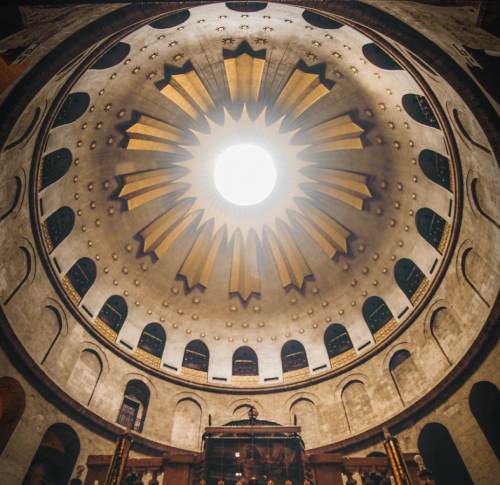
The nearby drinking hall was the scene of many furious drinking sessions culminating in murder and seemingly only interrupted by visits to the church.
“They kept drinking till Vespers and when the Earl went out Svein Asleifson walked ahead of him, but Svein Breast-Rope stayed behind, still drinking.”
The Orkneyinga Saga – Chapter 66
The church survived until the 18th century when stone was removed to build a new post-reformation church nearby. This new church did not survive long and is no longer visible.
Egilsay
Egilsay is historically significant as the site of the death of Saint Magnus, the Earl of Orkney, who was martyred in 1117. According to tradition, he was killed in the chapel on the island, which has since become a focal point of pilgrimage and devotion. To honour his legacy, a church was built on Egilsay in the 12th century, believed to have been constructed by his followers and the local community to commemorate his martyrdom. This church served not only as a place of worship but also as a memorial to Saint Magnus, emphasising his importance in the Christianisation of the Orkney Islands.

Over time, the church on Egilsay fell into disrepair, particularly during the Reformation in the 16th century, which led to a decline in religious practices and the abandonment of many smaller chapels and churches across Scotland. The shift in religious focus and the reduced population on the island contributed to its neglect. By the 18th century, the church was largely in ruins, reflecting the broader changes in faith and community life in the region. In addition to its connection to Saint Magnus, Egilsay holds significance for the Catholic Church as a place of pilgrimage and devotion, with many visitors drawn to the island to connect with its rich spiritual heritage.
It is also suggested that an earlier church may have existed at or near the location before Magnus’s death. The existing structure is the last remaining example of the round-towered churches found in the Northern Isles.
Eynhallow
Eynhallow holds a unique place in the religious history of Orkney, intertwining Norse folklore with the early Christian tradition. Known as the home of the finfolk in Norse mythology, the island also features the ruins of a medieval church, discovered by accident in 1851 when a fever forced the evacuation of its four families. As the roofs of their cottages were dismantled, the remnants of the ancient church became visible, revealing its significance as a place of worship. This unexpected discovery highlighted the island’s historical role in the spiritual life of the region.
Archaeological evidence suggests that the church may have served as a monastic site as early as the 1100s, although the exact details remain uncertain. The name Eyinhelga, meaning “holy island,” reflects its religious heritage. The Orkneyinga Saga mentions events that further connect Eynhallow to the ecclesiastical community, including the 1155 kidnapping of Olaf, the foster son of Kolbein Hruga, who may have been sent to the island for education by monks. This connection underscores Eynhallow’s potential role in the early Christian education and spiritual formation in Orkney.
It is now considered the church may have been part of a larger monastery. The site is now maintained by Historic Scotland.
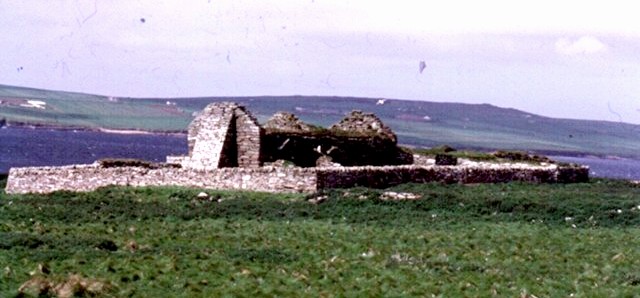
By the time of the Protestant Reformation in 1560, the church had likely ceased to function as a place of worship. Subsequently, it was repurposed into a two-storey dwelling, and its original structure was altered over the centuries. Despite these changes, remnants of the medieval church can still be discerned in the ruins today. The structure includes elements such as a porch, a rectangular nave, and a chancel, with visible traces of its earlier ecclesiastical function. Eynhallow, thus, remains a testament to the early Christian influence in Orkney and continues to be a site of historical and spiritual interest.
Other Sites
There are several sites of former Catholic churches around Orkney, for example, one dedicated to Saint Columba. This author has not had time to review or catalogue these. Perhaps someone would be so kind.
Preliminary details here: https://en.wikipedia.org/wiki/List_of_churches_in_Orkney
Catholic Place Names
Parishes
Most Orcadians today are very familiar with the notion of parishes. Everyone knows which parish they live in. In football there is the Parish Cup, some parishes have their own agricultural shows and many of the protestant churches still organise around the concept of parishes. However, local professor Dr Sarah Jane Gibbon has performed research into this and concludes that today’s parishes, or more correctly pre-1974 parishes, are the same as those created in the 12th century by the Catholic Church. There were various conjoinings of parishes from pre-Reformation times onwards, but the parish units remained cohesive. So for instance, Birsay and Harray have long been conjoined but the parishes have remained well-defined concerning identity and until recent times each had its own parish church. The Reformation caused no changes in parish structure or parish church location or building in Orkney which is in contrast to many other places in Britain.
St. Andrew’s
According to tradition, Saint Andrew was martyred at Patras in Greece, with his remains later moved to Constantinople and then to Amalfi in Italy. Legends involving King Angus and Saint Regulus offer explanations for how Andrew became the patron saint of Scotland and how his relics arrived in Fife. After the relics arrived, Andrew became a major cult, and the town now known as St Andrews grew into a powerful religious centre.
One theory suggests that King Nechtan of the Picts wanted to establish his kingdom as a Christian stronghold. Following his abdication in 738, his successor, King Angus I, sought to create a sacred centre similar to Lindisfarne, where St. Cuthbert’s bones lay, and arranged for Andrew’s relics to be brought to Fife. Although Saint Andrew’s relics never came to Orkney, his influence reached here, likely inspiring the naming of the Parish of St Andrew’s.
Non-Catholic Place Names
As a final thought on this history of Orkney from the Catholic perspective, it is interesting to note the village of Saint Mary’s in Holm. It would be reasonable to assume this would have some Catholic connection, but alas it does not. St. Mary’s was a planned village created when the Graemeshall estate underwent agricultural improvement in 1828. Alexander Sutherland Graeme named the village after his wife Mary Ann Graham. He was a strong supporter of all things connected with the Episcopal Church in Scotland, and this is likely why he combined his wife’s name with Saint Mary. It seems, however, many locals didn’t take well to the village name, and simply refer to it has Holm (pronounced ham).
This is not to be confused with another St. Mary’s, that being the southern third of South Ronaldsay, with St. Peter’s & Our Lady covering the northern two thirds of the island, including Paplay. All these names are distinctly of Roman Catholic origin.
Another location which you would be forgiven for having Roman Catholic connotations is the Whitechapel area of Kirkwall, just off Albert Street beside Lucano restaurant. This, however, takes its name from a house that was located in that area. The house once belonged to a Gilbert Nisbet and after him in 1691 to Robert Alexander, a sailor. Sometimes a house in Kirkwall fell into a son who had settled abroad or south, and this occurred with Whitechapel. The house was inherited by James Kelday who is designated “Wind musical instrument maker, St. Mary’s, Whitechapel, County of Middlesex”. This is the name we now recognise today (see the book Kirkwall in the Orkneys by B.H. Hossack of Craigiefield).

